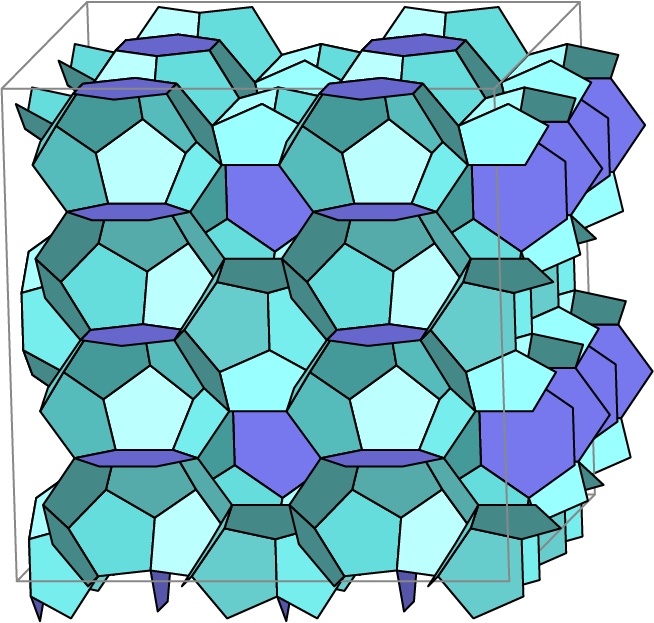When juice is frozen in the freezer, only the water freezes and the other ingredients concentrate and separate. The same thing happens with milk. Water dissolves many things in its liquid state, but ice hardly dissolves anything, so if you freeze an aqueous solution, only the water will freeze.
Even though water can dissolve many things, some things, such as gases and oils, do not blend with water and hardly dissolve. However, some of these molecules freeze together with water to form hydrate crystals. The most famous solid solution of water is methane hydrate.
Methane hydrate is a crystallized substance of methane and water. It looks just like ordinary ice, but its crystal structure is quite different. Ice I crystals have a hexagonal honeycomb structure, while methane hydrate has many pentagonal polyhedra.
Methane and water crystallize together, but this does not mean that methane molecules, which do not like water, form bonds with water. Methane molecules are trapped one by one in the polyhedral cages formed by water molecules, and they coexist at a good distance from water. Water molecules are stabilized by forming hydrogen bonds with the surrounding four molecules, just like ice.
The cage-shaped crystal structure formed by water is not only the structure of methane hydrate (I-type structure, CS-I). When water is in solid solution with molecules smaller than methane, another crystal structure called type II (CS-II) is formed. Ice XVI was created by removing neon from neon hydrate, which forms a type II crystal structure.
What would happen if instead of methane, we put a water soluble, water friendly molecule such as methanol in the cage? Methanol tries to make hydrogen bonds with water, but when water bonds with methanol, it is forced to give up one of its bonds with water, which in turn makes the water cage structure unstable. For this reason, a molecule such as methane, which does not get along well with water and is not soluble in water, is more stable as a crystal in the cage structure.
As mentioned above, methane hydrate looks just like ice, but it does not melt even at 0°C if the pressure is high enough. The deeper the ocean floor, the higher the pressure, while the temperature at the bottom of the deep sea is maintained at 4°C everywhere, so methane hydrate does not decompose at the bottom of the deep sea, and methane hydrate seems to be buried at the bottom of any ocean. Methane hydrate on the ocean floor is attracting attention as an energy resource to replace petroleum. On the other hand, methane is 20 times more potent than carbon dioxide in causing the greenhouse effect, so there is concern that if methane is released into the atmosphere after decomposition due to global warming, it will cause a positive feedback that will further accelerate global warming. There was a news report that the maximum increase (not the total amount) of methane in the atmosphere was recorded in 2021. It is not yet clear whether methane hydrate decomposition is responsible for this increase, but it should be watched closely.
ジュースを冷凍庫で凍らせると、水だけが凍って、水以外の成分は濃縮され、分離してしまいます。牛乳でも同じことが起こります。水は、液体状態ではいろんなものを溶かすのですが、氷はほとんど何も溶かさないので、水溶液を凍らせても水だけが凍ります。
水にはいろいろ溶けるといっても、気体や油のような、水になじまず、ほとんど溶けないものもあります。ところが、これらの水になじまない分子のなかには、水と一緒に凍って結晶を作るものがあります。2種類以上の物質が混ざったまま固化したものを固溶体と言います。水の固溶体のなかで、一番有名なものが、メタンハイドレートです。
メタンハイドレートはメタンと水が結晶化した物質で、見た目はふつうの氷そっくりですが、結晶構造はかなり違います。氷Iの結晶には六角形の蜂の巣構造が見えますが、メタンハイドレートの構造には五角形でできた多面体がたくさんあります。
メタンと水が一緒に結晶になる、といっても、水が嫌いなメタン分子が水と結合をつくるわけではありません。水分子がつくる多面体のカゴの中に、メタンが一分子ずつ閉じこめられ、水とはうまい具合に距離を保って共存するのです。水分子は水分子同士で氷と同様に周囲の4分子と水素結合を作って安定化します。実に巧妙な構造です。
水が形づくる、カゴ型の結晶構造はメタンハイドレートの構造(I型構造、CS-I)だけではありません。メタンよりも小さな分子と水が固溶体となる場合には、II型(CS-II)と呼ばれる、別の結晶構造ができます。氷XVIは、II型結晶構造を形成するネオンハイドレートからネオンを抜くことで作られました。
もし、メタンの代わりに、メタノールのような、水に溶けやすい、水と仲の良い分子をカゴに入れるとどうなるでしょうか。メタノールは水と水素結合を作ろうとしますが、水はメタノールと結合すると、水との結合を一本手放さざるをえなくなり、かえって水のカゴ構造は不安定になってしまいます。このため、メタンのように、水と仲の悪い、水に溶けにくい分子のほうが、カゴ構造の結晶は安定になります。
上にも書いたように、メタンハイドレートは、氷そっくりに見えますが、圧力が高ければ0℃でも融けません。海底では深いほど圧力は高くなる一方、深海底の温度はどこでも4℃に保たれているので、深海底ではメタンハイドレートが分解せず、どこの海の底にもメタンハイドレートは埋もれているようです。海底のメタンハイドレートは石油に代わるエネルギー資源として注目されています。一方、メタンは二酸化炭素の20倍もの温室効果をひきおこす物質なので、温暖化によって分解されたメタンが大気に放出されると、さらに温暖化を加速するという正のフィードバックを起こすことが懸念されます。折しも、2021年に大気のメタンの増加量(総量ではなく)が最大を記録したというニュースがありました。メタンハイドレートの分解がこの増大の原因かどうかはまだ明らかではありませんが、注視する必要があります。
genice2 CS1 -g 12=Me -r 2 2 2 -f svg[rotate=Y10,X10:polygon:margin=20] > MH.svg

water ice hydrate simulation genice メタンハイドレート